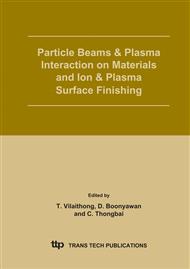p.69
p.75
p.81
p.87
p.95
p.99
p.103
p.107
p.111
Efficiency of Energy Transfer in a Small Plasma Focus Device
Abstract:
A study of energy transfer in a small plasma focus device has been carried out during its axial phase. The snow-plough model has been used in the simulation as a basic model for the calculation of plasma dynamics. The energy transferred to the plasma is calculated by considering the work done by the electromagnetic piston during the axial phase. It was found that the plasma energy calculated by this model agrees well with the experimental data within the pressure range of 1 mbar to 4 mbar if the mass shedding effect is included in the model. According to the present computation, the energy transferred into the plasma, in the case of a plasma focus with 2.3 kJ initial energy operated with nitrogen gas within the pressure range of 1 to 4 mbar, is between 224 J to 250 J. This corresponds to energy transfer efficiency of 9.6% to 10.7%. The mass shedding factor decreases from 0.23 to 0.069 with increasing pressure. Correspondingly, the energy transfer efficiency changes slightly at a higher pressure.
Info:
Periodical:
Pages:
95-98
Citation:
Online since:
October 2005
Keywords:
Price:
Сopyright:
© 2005 Trans Tech Publications Ltd. All Rights Reserved
Share:
Citation:


